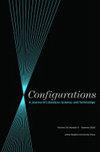The Protoplasmic Imagination: Ernst Haeckel and H. P. Lovecraft
IF 0.3
4区 文学
Q3 HISTORY & PHILOSOPHY OF SCIENCE
引用次数: 0
Abstract
ABSTRACT:This essay traces an imaginative history of protoplasm in the late nineteenth and early twentieth centuries. It is a material that still exists today, though, with the advent of DNA and cellular biology, in a somewhat different form. For the biologist Ernst Haeckel (1834–1919) and the short story writer H. P. Lovecraft (1890–1937), protoplasm was the key to the specific nature of evolved life. Not only was it the material that, in the living organism, was given shape, but it was also the place where the hereditary information of what shape to give was passed on from one generation to the next, making evolution possible in the first place. For Haeckel, it was the missing piece in the puzzle that Darwin had almost completed, and with it the whole mystery and wonder of life was within explanatory reach. For Lovecraft, on the other hand, it was the very essence of the shapeless, primitive, and fundamentally menacing quality of life that civilization had to keep at bay. Though protoplasm plays a very different role in modern science than it did then, its imaginative legacy lives on in a whole range of fiction genres nowadays, and Haeckel's and Lovecraft's both very different and very similar conceptions provide a starting point for exploring a conception of biological life that is far from dead.原生质想象:海克尔和洛夫克拉夫特
摘要:本文追溯了19世纪末到20世纪初的原生质发展史。然而,随着DNA和细胞生物学的出现,这种物质以一种不同的形式存在于今天。对于生物学家恩斯特·海克尔(Ernst Haeckel, 1834-1919)和短篇小说作家h·p·洛夫克拉夫特(h.p. Lovecraft, 1890-1937)来说,原生质是进化生命特定性质的关键。它不仅是生命体中被赋予形状的物质,而且也是遗传信息代代相传的地方,这使得进化成为可能。对海克尔来说,这是达尔文几乎已经完成的拼图中缺失的一块,有了它,生命的整个神秘和奇迹就在解释范围之内了。另一方面,对洛夫克拉夫特来说,这是一种无形的、原始的、从根本上具有威胁性的生活质量的本质,文明必须加以控制。尽管原生质在现代科学中扮演着与当时截然不同的角色,但其想象力的遗产在今天的一系列小说类型中仍然存在,海克尔和洛夫克拉夫特的观点既不同又相似,为探索一种远未死亡的生物生命概念提供了一个起点。
本文章由计算机程序翻译,如有差异,请以英文原文为准。
求助全文
约1分钟内获得全文
求助全文
来源期刊

Configurations
Arts and Humanities-Literature and Literary Theory
CiteScore
0.50
自引率
0.00%
发文量
33
期刊介绍:
Configurations explores the relations of literature and the arts to the sciences and technology. Founded in 1993, the journal continues to set the stage for transdisciplinary research concerning the interplay between science, technology, and the arts. Configurations is the official publication of the Society for Literature, Science, and the Arts (SLSA).
 求助内容:
求助内容: 应助结果提醒方式:
应助结果提醒方式:


